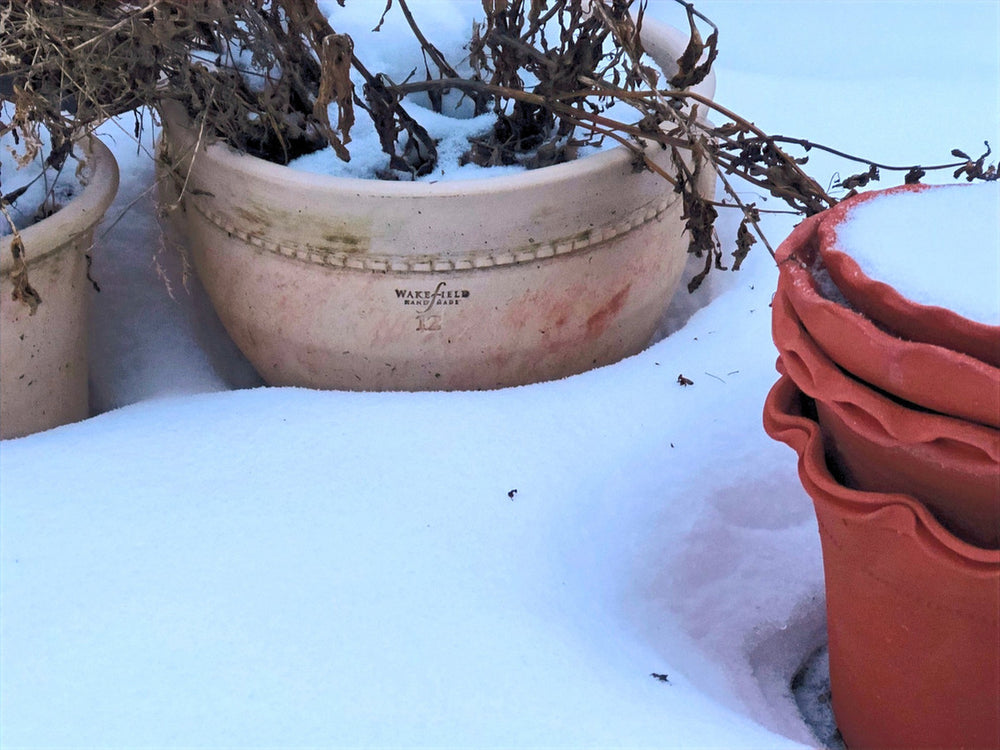
Frostproof is a word that many people in the US misunderstand, so I shy away from it. It is easy to confuse "frostproof" with freeze proof. When water freezes in an enclosed space, it expands forcefully enough to crack any rigid container, even cast iron.
There are potteries in Italy and the UK that offer a "frostproof guarantee" for their terracotta. In the climates of the UK or Italy, the temperatures may dip below freezing for a few days, but probably not for months at a time. I live in Wisconsin, so we expect the temperature to be well below freezing from December to March. The biggest freezing threat to my pottery in winter here in Wisconsin, is that the root ball and soil inside the pot may be damp enough at the onset of the freeze, that it will expand and crack the pot.
Frostproof really refers to whether or not the clay is fired high enough, (making it less porous) to keep the pot from delaminating once the temperature goes below zero. Delamination happens when the clay absorbs a lot of water, and then when it freezes, this causes the outside of the pot to flake away. My terracotta is fired to nearly 2000° F, (1090° C), so it does not have the open porosity of lower fired terracotta, and does not delaminate in cold weather.
I was so busy making pots in November and December, that the snow flew before I had a chance to dump out the soil and cover the pots on our deck. But as you see from the photo above, there is no delamination or scaling due to frost. Hopefully there are no cracks due to damp soil soil freezing solid. The other risk to pots freezing outdoors is if they are in full contact with the ground, patio or deck. This would allow water and snow to build up around the base, then the action of freezing and thawing can be damaging to the exterior. Pots that are left outside during the winter will survive best if raised on pot feet or blocks of wood.
Of course for the longest life of your terracotta flower pots, you should at the very least dump out the soil and turn them over or cover them for the winter in a cold climate like Wisconsin. Better yet, store them inside a potting shed for the winter, and you won't have to worry.
For some nicely detailed information about what qualities are needed in terracotta to make it frostproof, check out this blog post from Eye of the Day, a wonderful garden center in Carpenteria, CA that specializes in Italian terracotta.
There are potteries in Italy and the UK that offer a "frostproof guarantee" for their terracotta. In the climates of the UK or Italy, the temperatures may dip below freezing for a few days, but probably not for months at a time. I live in Wisconsin, so we expect the temperature to be well below freezing from December to March. The biggest freezing threat to my pottery in winter here in Wisconsin, is that the root ball and soil inside the pot may be damp enough at the onset of the freeze, that it will expand and crack the pot.
Frostproof really refers to whether or not the clay is fired high enough, (making it less porous) to keep the pot from delaminating once the temperature goes below zero. Delamination happens when the clay absorbs a lot of water, and then when it freezes, this causes the outside of the pot to flake away. My terracotta is fired to nearly 2000° F, (1090° C), so it does not have the open porosity of lower fired terracotta, and does not delaminate in cold weather.
I was so busy making pots in November and December, that the snow flew before I had a chance to dump out the soil and cover the pots on our deck. But as you see from the photo above, there is no delamination or scaling due to frost. Hopefully there are no cracks due to damp soil soil freezing solid. The other risk to pots freezing outdoors is if they are in full contact with the ground, patio or deck. This would allow water and snow to build up around the base, then the action of freezing and thawing can be damaging to the exterior. Pots that are left outside during the winter will survive best if raised on pot feet or blocks of wood.
Of course for the longest life of your terracotta flower pots, you should at the very least dump out the soil and turn them over or cover them for the winter in a cold climate like Wisconsin. Better yet, store them inside a potting shed for the winter, and you won't have to worry.
For some nicely detailed information about what qualities are needed in terracotta to make it frostproof, check out this blog post from Eye of the Day, a wonderful garden center in Carpenteria, CA that specializes in Italian terracotta.


Comments
Vonya Armanino
Hello
I love all of your pottery and have started quiet the collection! I’ve noticed one of my pots(was the white/cream) is turning a tan brown color.
How do I avoid this?
Thanks for your beautiful craftsmanship.
Vonya (from California)
January 09, 2023
Leave a comment
Also in Blog Posts
Patina on Terracotta Flowerpots
By Peter Wakefield Jackson January 13, 2023 1 Comment
Continue reading
Old English Watering Pots
By Peter Wakefield Jackson October 12, 2021 9 Comments
Continue reading
Centering Made Simple
By Peter Wakefield Jackson February 12, 2021 1 Comment
Continue reading